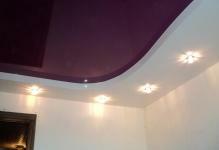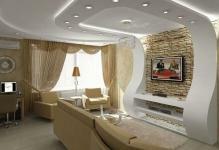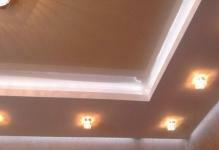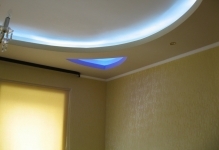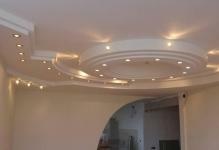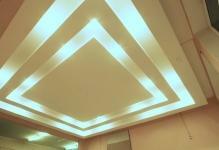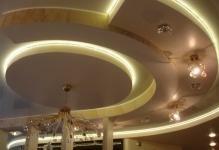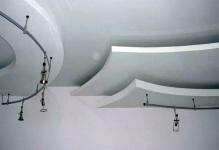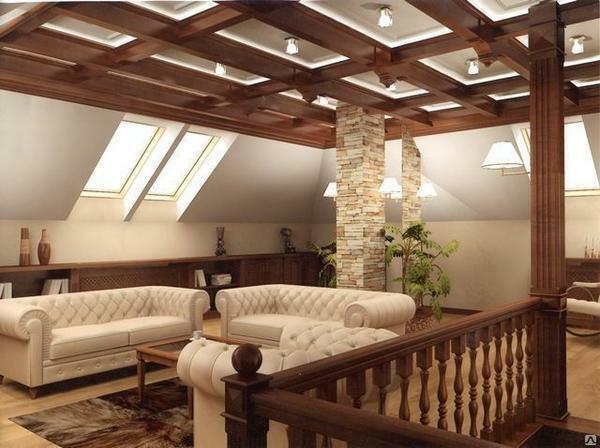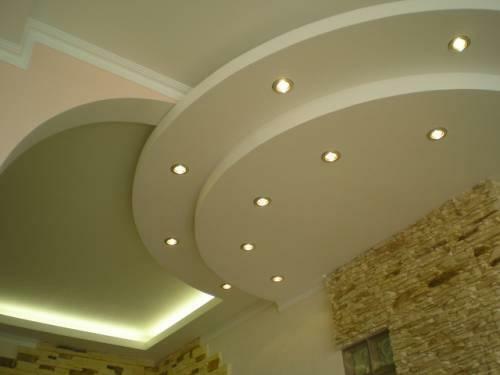 With the help of drywall you can change any room The multi-level ceiling made of gypsum cardboard is a suspension structure, the metal frame, which holds the weight of all this, is also mounted on several levels.
With the help of drywall you can change any room The multi-level ceiling made of gypsum cardboard is a suspension structure, the metal frame, which holds the weight of all this, is also mounted on several levels.
-
- How to make a multilevel ceiling of plasterboard with their hands
- Three-level ceiling of plasterboard with their hands: installation
- What is the soaring ceiling of plasterboard
- Multilevel ceilings plasterboard backlit own hands
- MultilevelPlasterboard streams( video)
- Multi-level gypsum ceiling with backlighting( photo)
How to make multi-level ceilings from gypsumTone your arms
surest option - installation of the first level of the drywall, and on top of it fastens the second level of CD-profiles. The main thing is to observe one single rule - not to combine in one plane the seams of several levels. That's why it's more convenient to make ceilings with curved lines and shapes - a new level of them will not be repeated anyway.
The first layer of gypsum board is fixed in the usual way - along the guiding profiles and the crate. The metal profiles themselves can be fixed rigidly to the black ceiling or stay on metal belts, and even along the perimeter( just on the screws).
Both versions are quite good, but the installation on the capital ceiling is not always reasonable( for example, if it is not even).
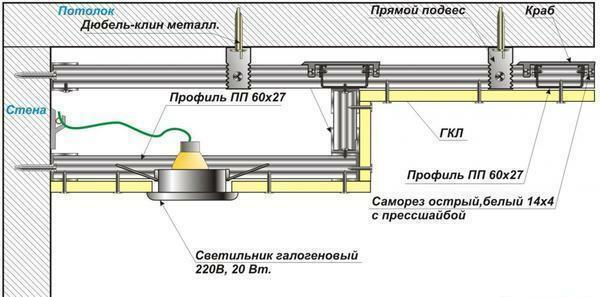 Diagram of a two-level ceiling construction
Diagram of a two-level ceiling construction
Total, raznosyarusnye gypsum board ceilings are mounted as follows:
- is first made the main layer of gypsum board in the usual way;
- further it is necessary to make a new skeleton under the second level, initially having set the box shape;
- further - step by step the new levels are fixed to the required height. All lighting and an electrician( wiring) will be hidden in the box itself.
Three-level ceiling from gypsum cardboard by one's own hands: mounting
You can, for example, consider the process of installing a three-level ceiling from gypsum board yourself. And the last layer will be "floating", that is, without attaching to the walls. Multi-tiers are done in the same way as the three-tier, only taking into account the static weight of the structure. Accordingly, for the first level, you need to make an extremely strong frame that can withstand not only the static but also the dynamic load( so that the ceiling does not collapse when flooded by neighbors above, for example).
So, the design is created as follows:
- First - the main crate of aluminum profiles.
- The crate is fastened to the first layer of gypsum cardboard and is rigidly joined at the seams by self-tapping fleas.
- Next on gypsum cardboard of the first level a new profile is laid. Rigidity of the construction will ensure installation around the perimeter.
- The device is then closed with the same gypsum cardboard box, aligned to the correct height.
- The last stage is a floating level of drywall that is fixed in the same way, but only closed CD profiles are used. The form is free.
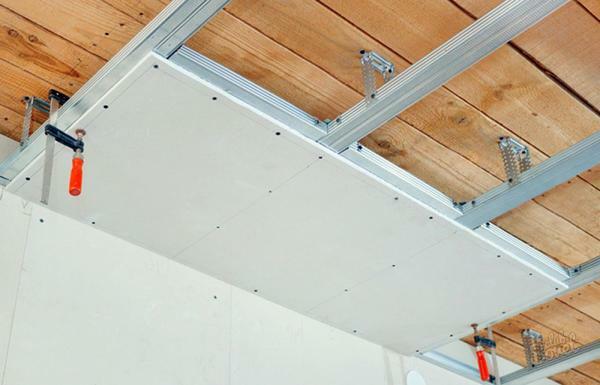 After installation of the first tier, wiring and other communications are mounted from the profile.
After installation of the first tier, wiring and other communications are mounted from the profile. . Similarly, tiered ceilings are installed, but instead of sheets of plasterboard a film is used. Backlighting is done in the last turn, that is, when the base of the ceiling is ready.
What is a floating ceiling made of plasterboard
A floating ceiling means that it does not have a perimeter mount. That is, it keeps on the profile of the crate, and visually everything looks as if it's on a drywall.
You can mount it using the standard method. If you plan to create a backlight around the perimeter of the soaring level, then niches are mounted there( special cornices can be used), inside which the LED strip of the desired shade is attached to the adhesive tape.
A floating ceiling is a separate type of soaring, only the initial level is made as if it is not connected to a wall. In fact, there is a fastening, but it is covered with the same bright backlight. Do not look at this option if you plan to mount a stretch glossy film.
It is recommended to use the thinnest drywall sheets for a floating ceiling. If the "floating" box is to be attached to the chandelier, then it is better to attach it to the first level of profiles or even to the capital ceiling. Wiring will still be located behind the false ceiling.
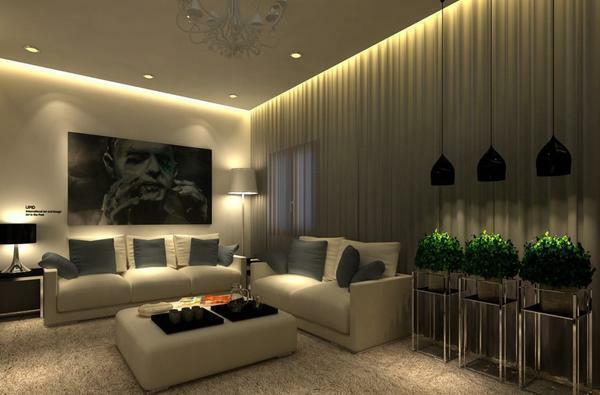 The effect of the floating ceiling is created by a light-emitting diode illuminated on the
The effect of the floating ceiling is created by a light-emitting diode illuminated on the
- LED strip for illumination of the floating ceiling;
- LED lighting;
- traditional candle lamps with directional light up.
In fact, design solutions are much more, and above are the simplest and inexpensive options for organizing backlighting.
Multi-level ceilings from gypsum board with illumination by one's own hands
A multi-level ceiling, in contrast to a single continuous layer, has a so-called deflection index. And it should be taken into account. Accordingly, the installation of one level in the second is done only rigid, without any screeds or suspensions, which can not withstand a mass exceeding 10 kilograms.
To create multi-level ceilings, use the appropriate classification profiles CD, D, CW, UW and the like. Only in this way the structure can easily withstand even the high humidity in the apartment( drywall like a sponge absorbs even the moisture that soars in the air).
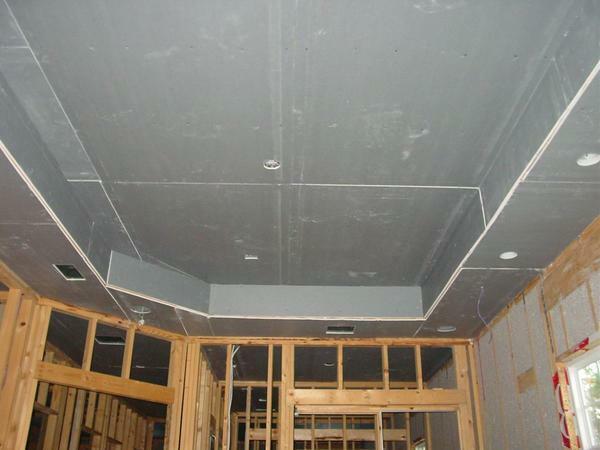 If the second level of the project has a curved or broken contour, then the strip cut from the sheet is soaked in water, after which the drywall becomes compliant and soft
If the second level of the project has a curved or broken contour, then the strip cut from the sheet is soaked in water, after which the drywall becomes compliant and soft
As for the backlight, LED strips and lamps are generally recommended in a separate niche made in the wall. Wiring is laid in any convenient way, but preferably not through the profile. Otherwise, when the wire is burned, it is necessary to disassemble almost the entire ceiling and remove the plaster layer.
On average, the maximum possible load level of the ceiling is:
- 100 kilograms to the first level( room 3 by 3 meters on average);
- 60 kilograms - on the second;
- 30 kilos - on the third.
These are the limit values. But the smaller the number, the better.
Multi-level gypsum board flows( video)
Total, it's not difficult to make a multi-level ceiling with your own hands. The only difficulty is the creation of a sketch over which plasterboard sheets will be placed, as well as cutting them. To create curly bends, it is better to use an electric jigsaw, and to cut all the sections of the slices with fine grain skins.

